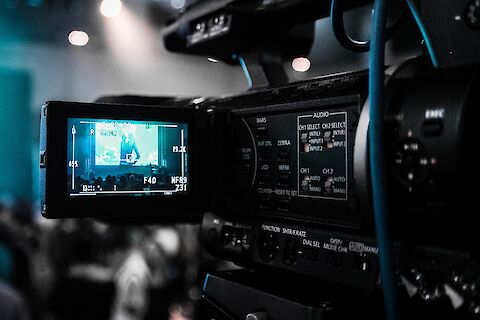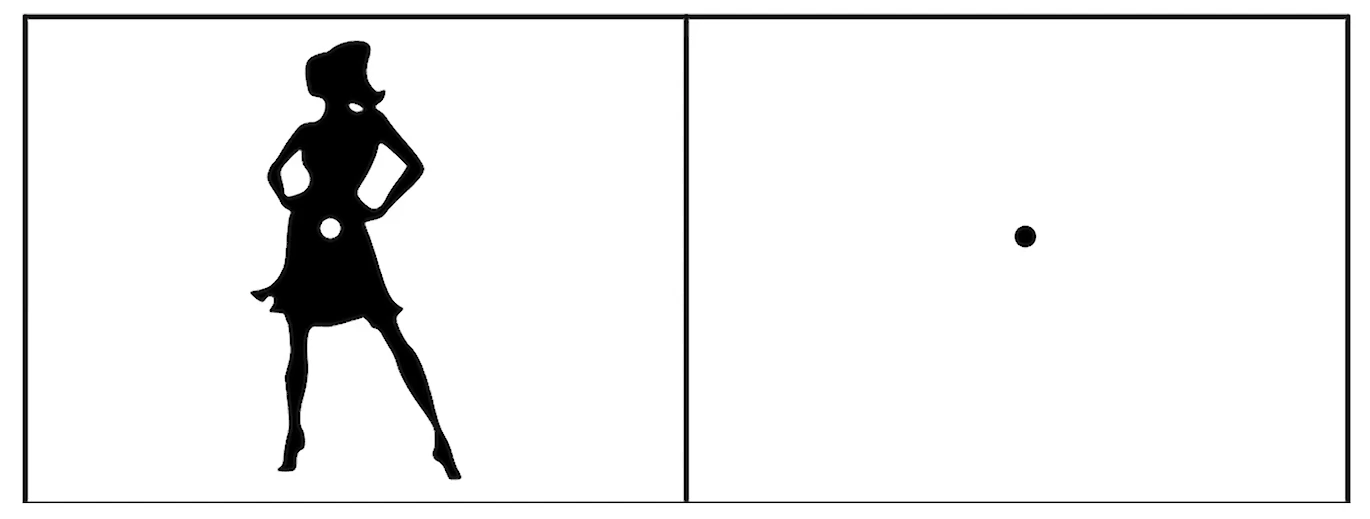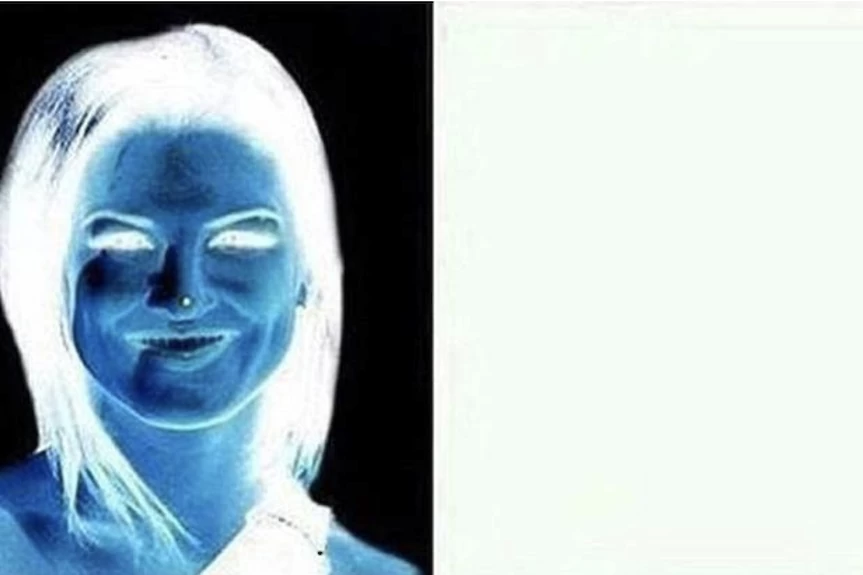

Palinopsia, afterimages and apparitions
Lighting affects the way our eyes perceive the environment around us. Changes can cause us to see things that are not really there. It makes me wonder, is there a connection between palinopsia, afterimages, and sightings of apparitions? Is the simple act of staring at the light on a video camera and then looking up causing us to see something that isn't really there? There is an optical illusion known as the afterimage which could provide us with a clue.
Afterimage
Light is something that has a huge effect on the way we experience things in a paranormal investigation. Often we are investigating with the lights off and using flashlights or lanterns. The problem here is that the rods in our eyes are sensitive to light. They don't interpret colour, only light. If our eyes are exposed to bright light, the cones and rods become overexposed, and often we will see a large flash of light, much like you see on an overexposed photograph. This can also cause a person to see what is called an afterimage.
Positive Afterimage
A positive afterimage is when you see an image that you continue to see in your vision when you are no longer looking at the image. It appears the same shape and colour as the image you are looking at.
Stare at the white dot on the left image for 30 seconds. Now move your line of sight to the black dot on the right. You will see a 'lady in white' slowly float down.

Source: Stuff Paranormal Investigators Need To Know Volume 1: What the eyes see and the ears hear the mind believes by Sarah Chumacero (2019)
While the cones reset really quickly, it takes the rods a lot longer to reset and adjust to the change in light. As we get older, our eyes degenerate. We all have varying levels of eyesight and different types of light have different luminosity which means that the time it can take to adjust to the dark is different for each person based on the health and condition of their eyes plus the type of light. It is different for example going from a Sunny room to a dark room as opposed to having a fluorescent light on which is then switched off.
When you stare at a black image for a prolonged period of time and then look at a white piece of paper, you can see the image floating down. It just shows us what happens when our eyes are trying to adjust. It can make us see things that are not there.
Negative After Image
A negative afterimage occurs when the rods and cones in our eyes become desensitized from being overstimulated. The desensitized areas are where the image is the brightest and the weakest where the image is dark. When you look away, this becomes reversed and creates a negative afterimage meaning you see the colours reversed to how they originally were.
Stare at the white dot on the nose of the woman for 30 seconds. Now move your line of vision to the blank space on the right of the image.

Image Source Daily Mail
While you may have expected to see some sort of demonic image, you actually end up seeing a pretty brunette because the colours are reverse aka a negative afterimage!
The code for all the hues we can experience in the light spectrum, this information is relayed from the back of the eye to the brain via three opponent neuron channels. Aside from the greyscale black and white channel, we also have a red and green channel and a third blue and yellow channel so that 'we can code for any hue that's in the environment. When you look at something that, for example, is yellow for a long period of time, you stimulate the cells that are positively sensitive to yellow – so in the yellow and blue channel. The cells' activity increases and after a bit of time the activity fatigues and declines. When you then direct your gaze at a uniform background – let's say a grey wall - then what happens is that the cell doesn't return to its resting activity, it goes much lower than that. It's that decline – the weakening of the yellow code - that codes for the opposite colour to become stronger, so you'll see blue.
Dr Juno Kim from the University of NSW School of Optometry and Vision Science
Source Daily Mail
The afterimage is a psychological optical illusion. This can however present in another way on a more spontaneous level which is considered to be a medical condition known as palinopsia.
Palinopsia
While we can induce an afterimage on purpose but staring at specially created images like the above to demonstrate how it works, there are people that deal with this on a daily basis thanks to a condition called 'Palinopsia'. The term comes from the Greek words Palin meaning again and Opsia meaning seeing.

Image Source: Healthline
Palinsopsia can present as a hallucination which can include moving images that are replayed over and over. There is also an illusionary version where you may see light streaks or images that appear to be moving behind an object. It is usually spontaneous and on many occasions the cause is unknown. It does however seem to happen a lot with migraine sufferers. As a migraine sufferer myself, I know that seeing an afterimage for me is very similar to the way I experience auras when I am getting a migraine. I am however not a DR so if you do start experiencing this kind of visual phenomenon on an ongoing basis, please seek proper medical advice. (We can't blame everything on being paranormal).
So how do we know if we are seeing is paranormal or just a form of an afterimage?
Apparition or Afterimage?
One of the more common experiences investigators report on an investigation is seeing an apparition. It happens quickly and often it is only seen by one person and not the rest of the group. Of course, there are a lot of unknowns, but we have to entertain the fact that in some cases it could be our eyes deceiving us. There is a lot of sitting and waiting and possibly staring happening during a paranormal investigation. We sit and stare down a long dark hallway waiting. Maybe we are focused on the screen of a video camera which again is emitting a light source. When you look up you think you see something. Could this very act of staring at a screen and looking up cause us to see a face or even a figure that is not really there? Look at the above example of the negative afterimage. While the blue and white colours were used, in a lot of cases people are using night shot or UV lights on cameras giving a green or pink hue to the video. When we see an afterimage, it is not going to look the same as it does on the camera. It can end up looking quite dark and maybe even perceived as a shadow figure.
One of the first things to do if you have a sighting is to close your eyes and see if the image is still there. In some cases, it is which means it has been caused by an afterimage. This phenomenon doesn’t necessarily discount an experience you have had or explain everything, but it could explain certain experiences. When we are dealing with light, we have to understand the effect this has on our vision. Our brains play tricks on us and we are not reliable in certain conditions. If you do have an experience with seeing an apparition, look at the circumstances before the sighting. Were you staring in the one spot for a prolonged period of time? Is there a difference in lighting? Was there a strong light source? Was the apparition the same shape as something you just saw in another area? It is always a good idea to document a location with photos and video. Sometimes there might be something in the corner that you don't take much notice of, such as something that seems insignificant like a picture hanging on the wall. This footage or a photo of the room will become a valuable debunking tool if you have an experience.
If you are really looking to document proper data, keep the lights on! While this still happens in daylight and with lights on, it may not be as much of a factor because you are not exposed to such drastic changes in light. From an investigation point of view, I promise you things can still happen in either the daylight or with the lights on. In fact when you interview people about their ghostly experiences, many have happened in the light of day. We don't have to wander around in the dark. Of course, there are some locations that don't have electricity so take along some red lanterns. Red light can actually assist your eyes to adjust with its natural night vision which can also help avoid optical illusions such as the afterimage occurring. You can read more on that here: Dark adaptation and red light
Of course, we all see and experience things differently. I tried the above exercise in the blue hue many times before I was able to see it, yet the black and white one works for me every time. A few friends were able to see the blue one the first time. Just like some of us have really good vision and others not so much, we also age and have different things going on with our vision. We see and perceive things differently. This is also why it is important to note that just because we didn't see something that someone else did doesn't mean that it didn't happen. It means they saw something you didn't so now put on that investigator's hat and start working out why!
Can you recall something you have seen on an investigation that was really just your eyes playing with you?
References:
https://www.ceenta.com/news-blog/why-do-i-see-afterimages
https://www.dailymail.co.uk/news/article-3145423/The-bizarre-optical-illusion-paints-stunning-brunette-woman-blank-canvas-simply-staring-s-nose-not-it.html
Paranormality: Why we see what isn't there by Richard Wiseman (2011)
https://www.healthline.com/health/palinopsia
Cover Photo by Donald Tong from Pexels
If you enjoy LLIFS, consider buying me a book (otherwise known as buy me a coffee but I don't drink coffee and I LOVE books). Your donation helps to fund the LLIFS website so everyone can continue to access great paranormal content and resources for FREE!

Top pages with similar subjects
Don't forget to follow the Facebook page for regular updates
Join the mailing list to receive weekly updates of NEW articles. Never miss an article again!
Buy the latest and past issues Haunted Magazine
Check out the books written by LLIFS
Comments
-
Bertil Hoberg 3 years ago
Thank you so much for your well researched and very interesting articles! I failed will all the experiments in this article. I am thinking that this could be because I am 64 years old, I have been a type 2 diabetic since 1994 and I have needed laser surgery on both eyes during the years. At one point I needed to have an injection into the yellow spot in my right eye. Also I have blue eyes and I have heard that people with blue eyes are colour blind.
Kind regards,
Bertil in Sweden :-)